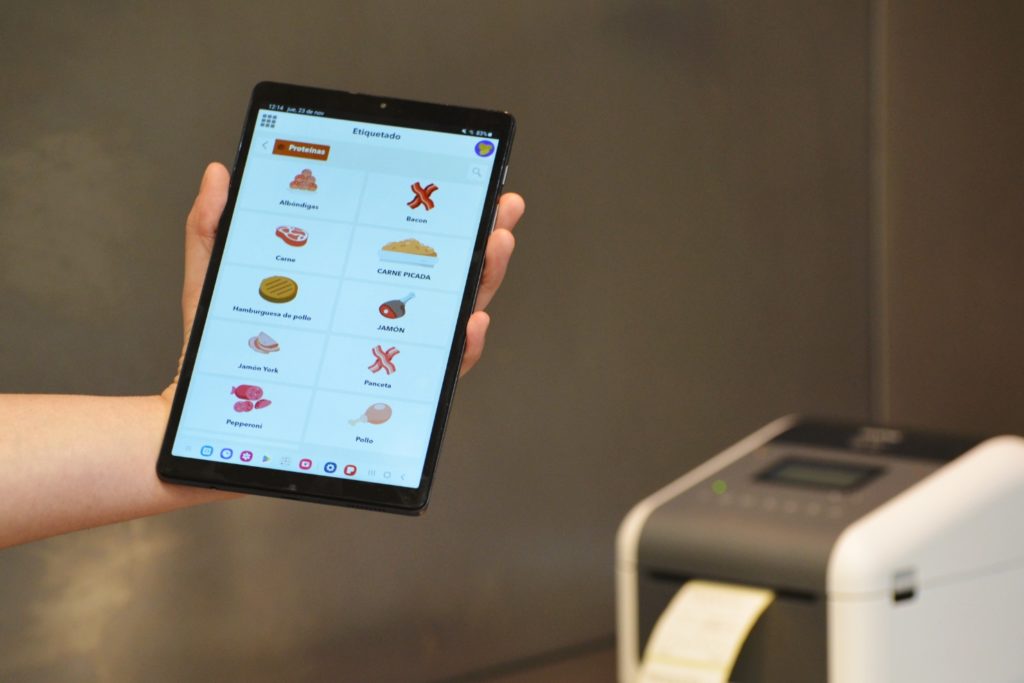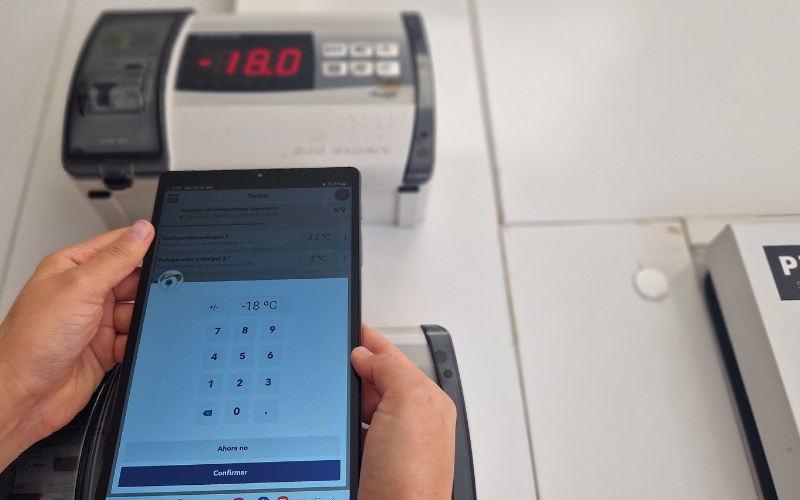Food Safety Challenges in 2024: How Andy is helping create a more resilient Food Service industry

What’s the first thing that comes to your mind when thinking about the future of food safety?
Smart fridges telling you it’s time to toss that wilted lettuce?
Apps tracking your groceries’ journey from farm to table?
AI chefs keeping an eye on perfect cooking temperatures?
You are not far from the truth!
However, while the future of food safety promises some mindblowing tech miracles, right now, it’s not all that bright and sparkly.
Climate change is shaking up farms, new germs are popping up faster than you can say “allergy”, and our food travels further than ever before, sometimes getting a little bumpy along the way.
Facing these food safety challenges isn’t about sounding the alarm.
It’s about understanding the dance between food and safety, so we can use tech to make it even better.
In this article we explore the food safety challenges we face in 2024, as well as the opportunities and many advantages afforded by smart food safety solutions like Andy!
Yes, there’s some doom and gloom, but also a lot of innovation and drive to overcome all these challenges!
Food safety challenges faced by the foodservice industry in 2024
Food safety challenge 1: Climate change
Extreme weather events like floods and droughts continue to disrupt food production and supply chains, increasing the risk of contamination and spoilage. Changes in temperature and precipitation patterns also favour the growth of certain foodborne pathogens.
This is particularly concerning in countries or regions like island nations where rising sea levels have a very serious impact on food safety.
Floods and droughts
- Contamination: Floodwaters can carry sewage, agricultural runoff, and other contaminants, polluting crops, and livestock water sources. This can lead to outbreaks of foodborne illnesses like E. coli or salmonella, as was the case with the coli outbreak linked to contaminated lettuce after a flood in California in 2019.
- Spoilage: Droughts can stress crops, making them more susceptible to mould, rot, and bacterial growth. Extreme heat can also accelerate spoilage during transportation and storage.
- Disruptions: Extreme weather events can damage infrastructure, transportation networks, and storage facilities, disrupting the supply chain and hindering access to safe food in vulnerable communities.
Temperature and precipitation
- Pathogen growth: Warmer temperatures create a more favourable environment for the growth of certain foodborne pathogens, such as Listeria and Vibrio cholerae. Changes in precipitation patterns can also impact the distribution of these pathogens.
- Foodborne outbreaks: Increased prevalence of certain pathogens can lead to more frequent and severe outbreaks of foodborne illness, putting additional strain on public health systems.
- Water scarcity: Droughts can lead to water shortages, making it difficult to maintain proper hygiene and sanitation practices in food production and preparation, further increasing the risk of contamination.
Food Safety Challenge 2: Emerging pathogens
New or evolving strains of bacteria and viruses can emerge – and are emerging! – unpredictably, posing unforeseen threats to food safety.
Unlike established foodborne pathogens, emerging ones can appear suddenly and spread rapidly, often with unknown characteristics and transmission pathways. This makes them particularly challenging to detect and address.
Some examples of these new varieties include novel strains of E. coli, antibiotic-resistant bacteria, and zoonotic viruses like Nipah virus, with the potential to cause severe illnesses and outbreaks.
What can be done to keep these new pathogens at bay?
Tracking and adapting to these emerging threats requires constant vigilance and adaptable safety protocols.
- Monitoring foodborne illness trends, genomic sequencing of pathogens, and collaboration between health agencies and research institutions are crucial for early detection and identification of emerging threats.
- Rapid risk assessment and dissemination of information to food producers, handlers, and consumers are vital to prevent widespread contamination and outbreaks.
- Traditional food safety guidelines may need to be updated and adapted to address the specific characteristics of emerging pathogens.
This might involve:
-
- New hygiene and sanitation procedures tailored to the pathogen’s transmission mode.
- Modified temperature control requirements for storage and preparation.
- Development of new testing methods and diagnostic tools.
- Advanced monitoring systems, data analytics, and even AI-powered solutions can help identify patterns and predict potential outbreaks of emerging pathogens.
- Real-time tracking of food sources and supply chains can facilitate targeted interventions and recalls if contamination is suspected.
Food Safety Challenge 3: Labour Shortage
The current labour shortage in the food service industry is a double-edged sword.
While businesses struggle to fill positions, a smaller workforce can lead to increased pressure and compromised food safety practices.
Understaffed kitchens often mean overworked employees rushing through tasks, potentially neglecting crucial hygiene steps like handwashing or proper sanitation of equipment. This creates a higher risk of cross-contamination and foodborne illness outbreaks.
What can be done to address the consequences of the labour shortage?
- Simply filling vacant positions isn’t enough. Comprehensive training programs on food safety practices are vital for new and existing staff. This includes proper food handling, temperature control, sanitation procedures, and allergen awareness.
- Regular refresher training and ongoing supervision are crucial to ensure consistent adherence to safety protocols, even during busy periods.
- Automation solutions can alleviate some pressure on staff and offer additional safeguards. For example, touchless technology for ordering and payment can minimise contact points and cross-contamination risks.
- Smart cooking equipment with automated temperature control can ensure consistent food safety, reducing human error and reliance on individual vigilance.
- Recognising the mental and physical demands of food service work can contribute to staff retention and improved safety practices. Fair wages, flexible schedules, and supportive work environments can help reduce stress and promote a culture of food safety.
Food safety challenge 4: Supply Chain Fragility
Globalised modern food systems rely on intricate networks of transportation, storage, and processing stages, stretching across continents and spanning multiple countries.
While this can offer diverse food options and affordability, it also creates a precarious system susceptible to disruptions at any point.
Political instability, natural disasters, trade disputes, or even minor logistical hiccups can cause ripple effects throughout the supply chain, leading to shortages, delays, and ultimately, compromised food safety:
-
- Spoilage and contamination: Delays in transportation or inadequate storage conditions can lead to food spoilage or growth of harmful bacteria, increasing the risk of foodborne illness outbreaks.
- Counterfeiting and adulteration: Disruptions can create opportunities for unscrupulous actors to introduce counterfeit or adulterated products into the food chain, posing serious health risks to consumers.
- Limited access to safe food: Shortages caused by disruptions can limit access to safe and nutritious food, particularly for vulnerable communities, and lead to malnutrition and health problems.
What can be done to mitigate these risks?
Investing in resilient and diverse food systems is crucial.
This includes:
-
- Geographic diversification: Sourcing food from multiple regions and suppliers reduces dependence on any single vulnerable point in the chain.
- Supporting local and regional agriculture: Building stronger local and regional food networks can decrease reliance on long-distance transport and provide greater control over food safety standards.
- Investing in sustainable practices: Promoting environmentally responsible agriculture and efficient transportation systems can lessen the impact of climate change and other environmental factors on food security.
- Advancements like blockchain technology and real-time data tracking can enhance supply chain transparency and traceability. This allows for faster identification and response to potential issues, ultimately protecting food safety.
Food Safety Challenge 5: Consumer Food Waste
Consumer food waste isn’t just an environmental and ethical concern; it can also pose a hidden threat to food safety.
Improper storage and handling of leftovers can provide the perfect breeding ground for harmful bacteria, increasing the risk of foodborne illness outbreaks.
Vulnerable populations, such as young children, elderly individuals, and pregnant women, are particularly at risk.
What can be done to mitigate this food safety challenge?
- Education campaigns and innovative solutions for food waste reduction can contribute to better food safety practices.
- Awareness campaigns: Educating consumers about safe food handling practices, like proper storage, reheating, and cross-contamination prevention, can significantly reduce the risk of foodborne illness.
- Smart storage solutions: Developing and encouraging the use of airtight containers, portion control tools, and smart fridges with expiration warnings can help consumers manage leftovers safely.
- Food waste reduction strategies: Apps that connect consumers with restaurants offering discounted surplus food, composting initiatives, and promoting meal planning can all contribute to reducing food waste and minimising the associated safety risks.

Andy App: addressing food safety challenges in the 2024 food service industry.
Not familiar with the Andy App?
In a nutshell, the Andy App is a cloud-based software solution designed to revolutionise food safety and HACCP (Hazard Analysis and Critical Control Points) management for food chain restaurants, supermarkets, hotels, and other foodservice businesses.
Here’s a quick breakdown of its features:
- Streamlined HACCP management: Andy allows you to create, customise, and manage digital HACCP plans with ease, including record-keeping, temperature monitoring, and task assignments.
- Food labelling and allergen management: With Andy you can simplify food label creation, comply with labelling regulations, and ensure clear allergen information for customers.
- Digital checklists and reminders: Andy allows you to maintain hygiene and sanitation standards with automated reminders and digital checklists for food prep, storage, and equipment cleaning.
- Digital self-auditing: With Andy you can ditch tedious paperwork and embrace digital, interactive audit checklists tailored to your specific food safety plan and HACCP requirements.
- Corrective action management: With Andy you can assign corrective actions to staff members, track progress, and ensure timely resolution of non-conformities.
- Real-time temperature monitoring: With Andy you can ensure proper food storage temperatures through connected thermometers and instant alerts for deviations.
- Incident and risk management: Track and document food safety incidents, analyze trends, and take corrective actions quickly.
- Training and reporting: Andy allows your teams to access online training modules, generate comprehensive reports on food safety procedures, and stay compliant with regulations.

The Andy App’s intuitive interface, customisable features, and mobile accessibility have attracted businesses in various countries beyond Spain – its country of birth:
- Andy App readily adapts to different regulatory requirements and foodservice workflows, making it versatile for diverse markets.
- Andy App can be easily accessed from any device and real-time data syncing allows for centralised management and remote monitoring.
- Andy App is available in multiple languages, including English, Spanish, French, and Portuguese.
- Proven effectiveness: Case studies and user testimonials showcase how Andy App has improved food safety compliance and reduced risks in various business settings.
In summary, Andy App’s user-friendly, comprehensive, and adaptable approach to food safety management has garnered widespread recognition and established it as a leading tool in Spain and internationally.
But how can Andy help your food service business face the food safety challenges of 2024 and beyond?
Let’s find out.
You don’t have to face the food safety challenges in 2024 alone!
Andy has been designed after carefully listening to the needs of thousands of food service businesses like you worldwide to support you and your teams in:
- Improving traceability and transparency throughout the supply chain.
- Automating temperature monitoring and data recording for better compliance.
- Providing training modules and real-time reminders for hygiene practices.
- Optimising inventory management to reduce waste and food safety risks.
Food traceability with Andy
Andy App’s smart and powerful tools shed light on the journey of every ingredient, from farm to fork. With Andy, transparency becomes the norm, not the exception.
- Traceability at your fingertips: Supplier Management: Andy App centralises supplier information, enabling you to track and assess their hygiene and safety practices throughout the chain.
- Batch Tracking: Forget tedious paper trails. Andy App lets you effortlessly track each batch of ingredients, from their origin to their final destination in your kitchen. Traceability becomes a seamless part of your workflow, not a paperchase.
- Digital Documentation: No more mountains of invoices and receipts. Andy App digitises all purchase orders, delivery notes, and relevant certifications, creating a tamper-proof historical record of every ingredient’s journey.
- Food Labelling: Say goodbye to label creation woes. Andy App generates accurate labels compliant with regulations, including allergen information, ingredients lists, and expiry dates.
- Real-time Updates: Prices change, recipes evolve. Andy App adapts in real-time, adjusting labels with updated information without the need for manual intervention.
Temperature control with Andy
Proper temperature management is crucial for preventing bacterial growth.
Andy App’s features can contribute to managing the risks of emerging pathogens:
- Advanced data analysis of food preparation and storage conditions can identify potential risks.
- Automated reminder systems for hygiene and sanitation protocols can ensure consistency and compliance.
- Real-time communication platforms can facilitate rapid information sharing and response to emerging threats.
Andy: A Lifeline for the Staff-Starved Commercial Kitchen in 2024
The foodservice industry is grappling with a staffing crisis, leaving kitchens understaffed and scrambling to maintain safety standards.
Andy App emerges acts as a safety net, providing vital support to navigate the labour shortage in 2024.
- Automated tasks: Imagine time-consuming tasks like temperature monitoring, digital checklists, and routine data entry handled seamlessly by Andy App. This frees up precious staff time for more crucial tasks, like food preparation and customer service.
- Streamlining training: Andy App offers interactive training modules and digital resources, allowing new staff to get up to speed on food safety procedures quickly and efficiently. This reduces reliance on experienced staff for training, maximising their productivity.
- Prioritising compliance: With automated reminders and real-time alerts for critical tasks, Andy App ensures adherence to food safety protocols even amidst the hustle and bustle of a busy kitchen.
Less time spent checking boxes means more time focused on actual safety measures.
- Improving communication: Andy App’s digital platform facilitates clear communication between staff, managers, and suppliers. This ensures everyone is on the same page, minimising errors and confusion, especially during shift changes or peak hours.
- Data-driven insights: Andy App analyses trends in food safety practices, identifying areas for improvement and potential risks. This allows managers to allocate resources and training effectively, maximising their impact with limited staff.
- Predictive maintenance: Smart tools within Andy App can monitor equipment performance and predict potential issues before they occur. This proactive approach prevents costly breakdowns and disruptions in a labour-short environment.
- Reduced stress and fatigue: By streamlining processes and automating tasks, Andy App alleviates the pressure on staff, enabling them to work more efficiently and with less stress. This can lead to improved morale, reduced turnover, and a more enjoyable work environment.
- A partner in compliance: With Andy App on board, staff can approach inspections with confidence. Digital logs, automated reports, and readily available data ensure transparency and ease compliance, reducing anxiety and promoting a focus on food safety excellence.
Minimising the impact of supply chain disruptions with Andy
-
- Supplier management tools: Andy helps you track and assess the hygiene and safety practices of suppliers throughout the chain.
- Digital food logs and documentation: With Andy you can enhance traceability and transparency, allowing for rapid identification of potential contamination sources.
- Inventory management and optimisation: Andy helps reduce food waste and ensure the availability of safe food by forecasting demand and optimizing storage conditions.
A partner in reducing food waste and promoting safe food handling practices
-
- Meal planning and recipe suggestions: Andy helps teams plan meals and utilise ingredients effectively, minimising leftovers.
- Leftover storage optimisation: Andy provides information on proper storage times and temperatures for different food types.
- Reminder systems: Andy offer customisables reminders for reheating leftovers or cleaning food storage containers.
Empower your teams in the food service industry with a food safety management software and create a resilient, food safety challenge-proof business.
Try Andy and revolutionise your food safety processes in 2024!

